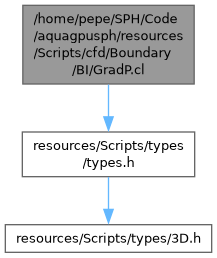Compute the gradient of the pressure at the boundary to impose the Neumann BC. More...
#include "resources/Scripts/types/types.h"
Include dependency graph for GradP.cl:

Functions | |
| __kernel void | freeslip (const __global uint *iset, const __global int *imove, const __global float *shepard, const __global float *rho, const __global vec *lap_u, const __global vec *dudt, __global vec *grad_p, __constant float *visc_dyn, __constant float *refd, unsigned int N, vec g) |
| Compute the gradient of the pressure at the boundary to impose the free-slip BC, i.e. | |
Detailed Description
Compute the gradient of the pressure at the boundary to impose the Neumann BC.
Function Documentation
◆ freeslip()
| __kernel void freeslip | ( | const __global uint * | iset, |
| const __global int * | imove, | ||
| const __global float * | shepard, | ||
| const __global float * | rho, | ||
| const __global vec * | lap_u, | ||
| const __global vec * | dudt, | ||
| __global vec * | grad_p, | ||
| __constant float * | visc_dyn, | ||
| __constant float * | refd, | ||
| unsigned int | N, | ||
| vec | g | ||
| ) |
Compute the gradient of the pressure at the boundary to impose the free-slip BC, i.e.
\( \left. \frac{d\mathbf{u}}{dt} \right\vert_{\partial \Omega} \cdot \mathbf{n} = \left. \frac{d\mathbf{u}}{dt} \right\vert_{\partial \Omega} \cdot \mathbf{n}\).
Such that the pressure can be computed from the Momentum Equation.
- Parameters
-
iset Set of particles index. imove Moving flags. - imove > 0 for regular fluid particles.
- imove = 0 for sensors.
- imove < 0 for boundary elements/particles.
shepard Shepard term \( \gamma(\mathbf{x}) = \int_{\Omega} W(\mathbf{y} - \mathbf{x}) \mathrm{d}\mathbf{x} \). rho Density \( \rho \). p Pressure \( p \). rho Density \( \rho_{n+1} \). lap_u Velocity laplacian \( \Delta \mathbf{u} \). dudt Velocity rate of change \( \frac{d \mathbf{u}}{d t} \). grad_p Pressure gradient \( \frac{\nabla p}{rho} \). visc_dyn Dynamic viscosity \( \mu \). refd Density of reference \( \rho_0 \). N Number of particles. g Gravity acceleration \( \mathbf{g} \).
Here is the call graph for this function:
